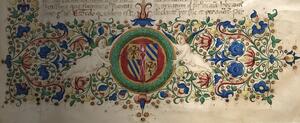Conference explores ‘Conspiracies Then and Now’
In early 2016, USC’s Doheny Library began digging for treasure. Four years later, with the support a USC Dean’s Challenge Grant, USC Libraries’ University Librarian and Digital Humanities Liaison, Danielle Mihram, together with the Head faculty Librarian of the Hoose Library of Philosophy, Melissa Miller, are sharing with the world some owhat they and their colleagues have discovered.
According to Mihram, “It is not until 2016 that manuscripts in our USC collections started to become ‘discoverable’ thanks to the cataloguing initiative undertaken by Melinda Hayes (Rare Books Librarian and Cataloguer, Special Collections).” Hayes began a process of physically examining books created before 1601, as well as 2500 other titles in USC’s Special Collections published before 1701. By current count, USC holds 28 medieval and renaissance manuscripts, 16 of which are illuminated.
Most of these manuscript treasures, Mihram explains, “were acquired in the early-mid 20th century by Ralph Tyler Flewelling, an American Idealist philosopher, who joined USC in the Fall of 1917, as Head of the Department of Philosophy.” Due to the complexities involved in cataloging them, their contents and character became lost in a morass of printed references, handwritten inventories, and card catalogs. Now that they have been re-discovered and more fully cataloged, Mihram and Miller are using “born digital” publishing techniques to transform texts handwritten onto animal skin into digital documents accessible to a wide audience.
Miller observes, “Manuscripts, specifically illuminated medieval manuscripts, are not only surviving works of art from 500-700 years ago but are witnesses to the social and cultural heritage of a time and place when the world, and the structures within it, were radically changing. These manuscripts have many stories to tell and the thrilling part is we have the opportunity to help tell these stories.”
Scalar, the publishing platform that Mihram and Miller used for the project, has particular advantages, “Scalar is a free, open source authoring and publishing platform that enables users to assemble media from multiple sources and juxtapose them with their own writing. Equally important, Scalar is different from a lot of platforms in that it supports collaborative authoring and reader commentary and enhances teaching, learning, and research.” Another comparable Scalar project that Mihram recently oversaw, USC’s Digital Voltaire, in 2017 provides access to a collection of 30 letters and 4 poems, also discovered USC’s holdings, written by the famed Enlightenment philosopher.
A born digital publication is by design always a work in progress. For the moment, the Scalar project features folios from four of USC Libraries manuscripts. These include two lavishly illustrated Books of Hours (private prayer books), a sheet of liturgical music, and a fifteenth-century copy of the treatise De Officiis (or, On Duties) by the Roman statesman and philosopher Cicero.
Dornsife College’s Frederic Clark, Assistant Professor of Classics, who also has contributed to this project, already utilizes that last manuscript in his teaching. “Showing it to students has been a highlight of my courses, especially my Latin class,” he notes. Students actually can begin to decipher the dense and heavily abbreviated handwriting and to spot differences between the 600-year-old copy and that of a 2000-year-old text. These textual variants “show firsthand the long and winding road of transmission that the text has traveled—from Cicero’s 1st-century BCE world to an undergraduate Latin course. Plus, students discover that medieval readers were fond of marking up their manuscripts, not unlike how we might write in our textbooks today.”
The model of collaborative learning and editing that Clark has developed for his classes is one that Mihram and Miller would like to see continue as the project develops and expands. At times, these processes have as much to do with archaeology as with editing. The next step for their Scalar project, “is to move our project beyond its current historical and visual analysis by using analytical methods and scientific analyses (for example, advanced imaging technologies, fluorescence microscopy, and analytical algorithms) as indispensable tools for the comprehensive study of our manuscripts as artifacts.”
Sometimes, though, physical quirks in manuscripts just jump out at you, even without sophisticated scientific instruments. Research Associate, Micaela Rodgers, who is working alongside Mihram and Miller on the project, notes that she was surprised to see that one of the library’s medieval manuscripts “was rebound with bright pink printer’s waste! It is so vibrant that it can be seen through the fine parchment—what binder would select such a vibrant color for this piece? This is where book and fashion history can play a role in elucidating a detail in a manuscript.”
Before the invention of the printing press, every book was a unique product, a treasure of artistry and beauty and a trove of historical and cultural information. The CPW community is fortunate to have access to these artifacts and looks forward, in collaboration with Mihram, Miller, and the USC Libraries’ Special Collections Department, to building around them a working community of a wide range of disciplines and campuses and even countries.
The Digital Humanities Scalar Project, USC Libraries, USC Illuminated Medieval Manuscripts, may be accessed at this link:
https://scalar.usc.edu/works/usc-illuminated-medieval-manuscripts/index
The companion publication is a rich USC Libraries Research Guide,Medieval Studies and Research, and may be accessed at this link:
https://libguides.usc.edu/MedRenMSSandRareMatStudies
The Digital Voltaire Project may be accessed here:
